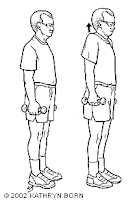I thought for awhile before admitting that I didn't know if there was such a document in existence. As soon as I said that I started thinking that I should write one! I worked in Physical Rehab and Skilled Nursing for five years and encountered several clients who started out completely dependent but who eventually made their way back to function.
So, for all you new OT's, caregivers, and parents out there, here are some guidelines for progressing a patient, a family member or a child from dependence to independence in physical tasks:
1) Bed Mobility (moving around in bed and getting in and out of bed)
This is definitely a Physical Therapy area of expertise but drawing from my collaboration with PT's over the years here are some basics:
- Work on rolling, with assistance and with equipment (then with no assistance and no equipment)
- Progress to sitting up, with assistance and with equipment ((then with no assistance and no equipment)
- Your patient is independent (or modified independent, with equipment) when they can roll side to side without assistance, sit up at the edge of their bed without assistance and get back into lying down without assistance.
2) Transfers (getting from one surface to another, ie. from wheelchair to the toilet, from bed to walker)
Generally PT's and OT's work together on transfers, however its usually the OT who covers the instruction and practice of toilet transfers and shower transfers.
- Start practicing transfers using a mechanical lift or a standing lift, a slide board and potentially two caregivers if your patient can't bear their weight through their legs
- Once your patient can bear weight through their legs with assistance, start using a bed rail (if your patient is unsteady in sitting), a pivot disc (if your patient can't step/move their feet), then a walker (if your patient is strong enough to bear weight through their arms and can step their feet) or hemi walker (if your patient can only use one arm for support), and eventually a cane (if your patient's balance is unsteady) or quad cane (again if your patient can only use one arm for support).
- Once you are able to stand by and observe your patient doing the entire sequence of movements safely with their equipment or completely independently to various surfaces safely, your patient has mastered transfers.
3) ADL (Activities of Daily Living, ie: dressing, medication management, self-feeding, grooming, bathing, toilet hygiene, meal preparation)
This is the "bread and butter" of OT's. We instruct family members, caregivers and of course patients on how to do their daily activities after their injury or illness.
- Start with your patient in their most supportive position, the head of their hospital bed inclined or in a supportive wheelchair/chair.
- With assistance and equipment, (a bedrail, trapeze, sock aide, long handled reacher, shoe horn, utensil holder, or a curved utensil) instruct your patient do as much of the activity as they can.
- If your patient is not safe in sitting work on getting dressed, groomed, bathing and even doing toilet hygiene in bed, again with assistance and with equipment as needed.
- When your patient has started to master ADL in bed, then in supported sitting, move on to doing them in unsupported sitting, and then eventually without equipment or assistance.
- As your patient can do ADL in unsupported sitting have your patient try the same task without equipment to challenge their strength, range of motion and coordination.
- Your patient may not complete the activity without equipment the first time but its important to continue to challenge your patient to regain as much of their prior level of function as possible.
- As your patient is able to sit unsupported for their ADL with or without their equipment, continue working on standing.
- At first they might need a standing frame to help maintain their balance, but with practice and time you can progress your patient to standing with a walker and assistance, to eventually standing independently at the sink for ADL.
- If your patient can get fully dressed, brush their teeth, feed themselves, go to the bathroom and wipe themselves, pull up their pants and take a shower with their equipment or without, they have mastered ADL.



4) Mobility
This is one of the main roles of Physical Therapy in Physical Rehabilitation and there is so much to this area of physical rehab I would defer to their expertise and extensive knowledge base. But just like Bed Mobility, there are some basic guidelines:
- Start out with the patient in the most supportive position and get them standing on their feet, (with assistance and equipment).
- As the patient progresses remove assistance and upgrade or remove equipment until the patient can stand on their own.
- At the same time you will also help the patient take steps (with assistance and equipment).
- Try to remove assistance and again upgrade or remove equipment to continue to progress the patient's abilities.
- Start to add on turns, backing up, inclines, declines and various types of ground (rough, smooth, uneven...etc) until the patient is independent, safe and can move freely in their environment.
Unfortunately, no matter how hard you try, some patients won't completely recover from their injury or illness. This could be because the damage to their brain or body was so significant that no amount of therapy could undo it. I would like to offer that it could also be because they don't have the motivation or inner will to continue to fight. At some point your patient may say to you, "Why are you pushing me so hard when I am happy with the way things are and can do things on my own, my way?" That should be a cue to you, as their family member, therapist or caregiver, to stop and consider, then accept their new reality.




















.jpeg)
-201277-PRODUCT-MEDIUM_IMAGE.jpg)

